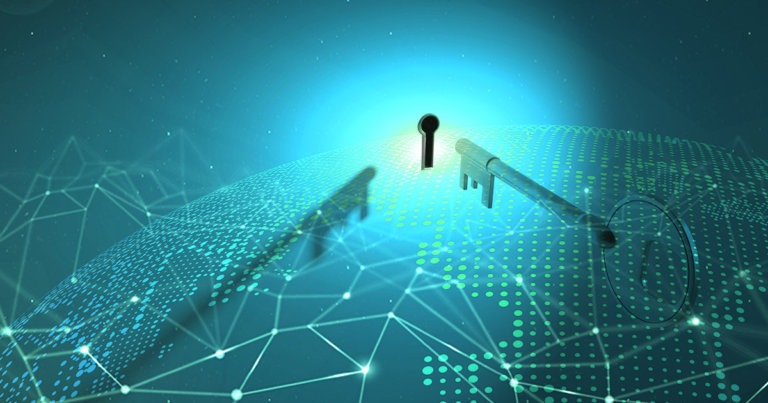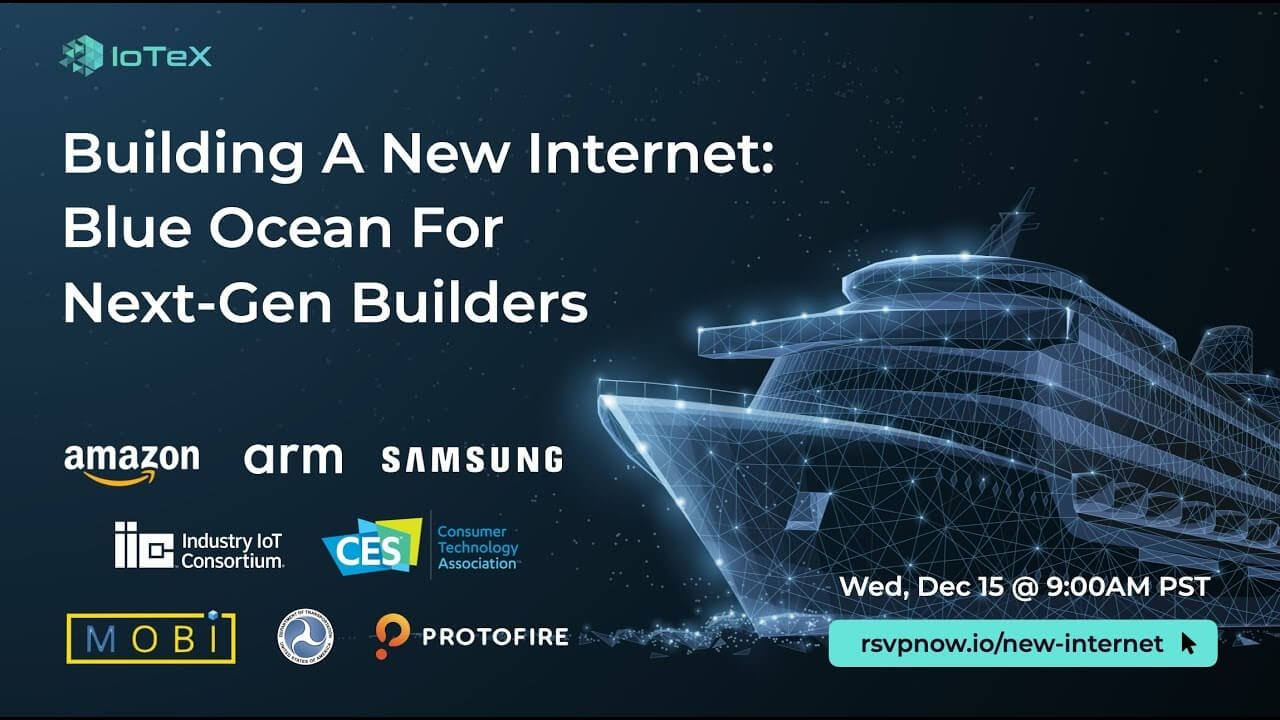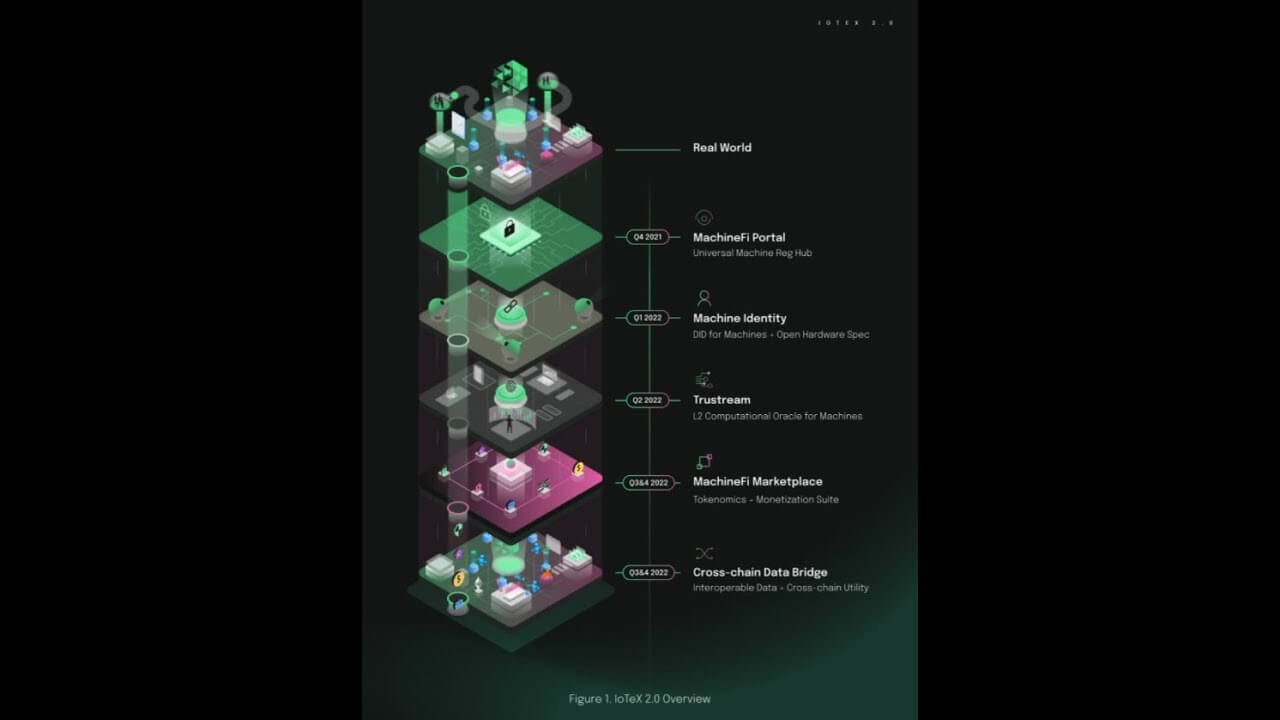 Unlocking the $12.6-Trillion machine economy on Web3
Unlocking the $12.6-Trillion machine economy on Web3 Unlocking the $12.6-Trillion machine economy on Web3
Blockchain expert explains the three phases of the world wide web; Web1, to Web2, and now to Web3.

Cover art/illustration via CryptoSlate. Image includes combined content which may include AI-generated content.
Web3 is poised to disrupt the internet. It already has in many ways. It’s paving the way to a multi-trillion-dollar decentralized machine economy at the forefront of which IoTeX stands. This, according to highly-regarded engineers and technologists leaders from Amazon, Samsung, Microsoft, Consumer Technology Association (CTA), and the International Internet Consortium (IIC).
“IoTeX is, interestingly, kind of in a sweet spot right now,” said Amazon Global Blockchain Leader Anoop Nannra in a recent Web3 panel. “If I look at the way you […] are approaching what you do, and how you do it, I think IoTeX is very unique. I think there are a lot of opportunities there, and I think the ecosystem will reward itself and the broader community that is around that ecosystem.”
The highly-regarded blockchain expert also said he sees a significant “upside” to IoTeX’s goal to decentralize the machine economy via Web3. That is where users will own their data, smart devices, and the value they generate instead of being dominated and monetized only by Big Tech.
“I think the (IoTeX) ecosystem will reward itself and the broader community because ecosystems are not in isolation,” Nannra added. “There’s a lot of upside not just from a monetary perspective but even just from advancing state of the art.”

The ‘Web-olution’
“There’s a lot of opportunity in —Web3 and MachineFi— not just from a monetary perspective but also in advancing state of the art, so I am really excited about that,” Nannra added.
The blockchain expert explained the three phases of the world wide web, invented in 1989 by British computer scientist Tim Berner-Lee, while working at CERN, the European Organization for Nuclear Research. He conceived and developed it for information sharing and messaging for scientists and universities worldwide. On April 30, 1993, Berners-Lee released the source code for the first global web browser and editor or Web1.
“We went from Web1 with no real notion of strong identity or security,” Nannra said. “We then went to Web2 where we started thinking about identity and interacted with the broader creator and producer community, documents, videos, and what have you. And now to Web3, where we’re actually, truly encapsulating value and generating entirely new business models that weren’t possible in Web2.”
NPR’s take is that Web1 was a disorganized but democratized way to access information worldwide. Web2, which started in the mid-2000s, is when Google, Amazon, Facebook, and Twitter brought order making it easy to connect and transact, but ultimately amassed too much power. “Web3 is about grabbing some of the power back.”
Nannra participated in the “Unlocking the Trillion-Dollar Potential of IoT and Blockchain” panel on December 15 alongside Mitch Tseng, IIC Chair of the Testbed Council and Edge Computing Task Group, and IoTeX Co-Founder Jing Sun.
Mitchell Kominsky, CTA Director of Government Affairs for Self-Driving Vehicles, Transportation, and Smart Cities, participated in the panel as well. He’s also been with the US Department of Transportation and Stanford University. Also present was Robert Parker, Bright.ai Co-Founder, and former AI, IoT, and Engineering lead executive at Microsoft, Samsung, and Amazon.

A ‘Matter’ of issues
He brought up an interesting point. How Google, Samsung, Apple, and Amazon are trying to solve smart device interoperability with Matter, which Big Tech describes as the solution to creating more connections between more objects, simplifying the development of smart devices for manufacturers, and increasing compatibility for consumers. This problem has significantly slowed down smart home adoption.
“Matter addresses all these different smart devices, but it doesn’t really solve the problem,” Parker stated. The problem is the high cost of intelligent device data management and device interoperability and how that conflicts with a business model that makes sense. “With Matter, vendors are starting to be able to interoperate between devices, but that won’t be the solution.”
“You will need things like the IoTeX platform to create something where you can operate in a scalable multi-vendor environment,” he said.
Parker also said IoTeX would play a significant role in solving the issue of scalability and interoperability. IoTeX is creating a completely separate network from Big Tech. “It will become the most relevant” and solve the problems Big Tech can’t, not even with Matter.

A year of epic proportions
“I think 2021 was pretty monumental in terms of how communities form and I believe next year,” particularly pertaining to the work of IoTeX is going to be by extension more creative in how Web3 can build, invest and create different applications, said Michael Kominsky of CTA, a trade association that represents United States’ $422-billion consumer technology industry, which supports more than 18 million US jobs.
“So, I think we’re really just starting to scratch the surface,” he said. “I’m excited to see how communities will change and invest in various areas (of Web3),” Kominsky stated.
Jing Sun said that the transition into Web3 has already started. “Finance has transitioned into DeFi (decentralized finance), which grew to $200 billion within two years. We’ve also seen transitions in the gaming, collectibles, and social media industries. They grew by $100 billion this year,” she added.

New Year resolutions
“2022 will be a critical year for the entire IoT machine industry because it will be the first year that we will see the first batch of MachineFi use cases,” Sun said. “The transition will expand to more industries next year.
Next year will be significantly important in the machine economy sector as IoTeX connects the physical world into Web3. “This will unlock huge possibilities that were still not possible this year even with Web3. We are now seeing developers building use cases, decentralized applications, and other new models that will unlock extraordinary value.”
Dr. Tseng said that in 2022, the IIC —a global non-profit partnership of industry, governments, and academia— has plans to start looking into IoTeX’s MachineFi vision because he believes “it can support us (the Industry IoT Consortium) and help solve problems.”
He spoke of the issues his organization sees in the IoT community. “We have a lot of people contributing in the virtual world and also in the software and physical domains, which means we are now talking about using the digital twin to connect these entities,” he added.
“But when we use a digital twin, we face a lot of issues, such as data integrity. How do we trust the information being passed along? This can be a show-stopper for us,” Tseng said. “So, what we are looking for is a secure environment where we can trust all the data and transactions.”
After conversations with IoTeX team members, Tseng said he is “convinced that MachineFi” is the solution the IIC needs, and it is something the consortium will look into in 2022.





















































